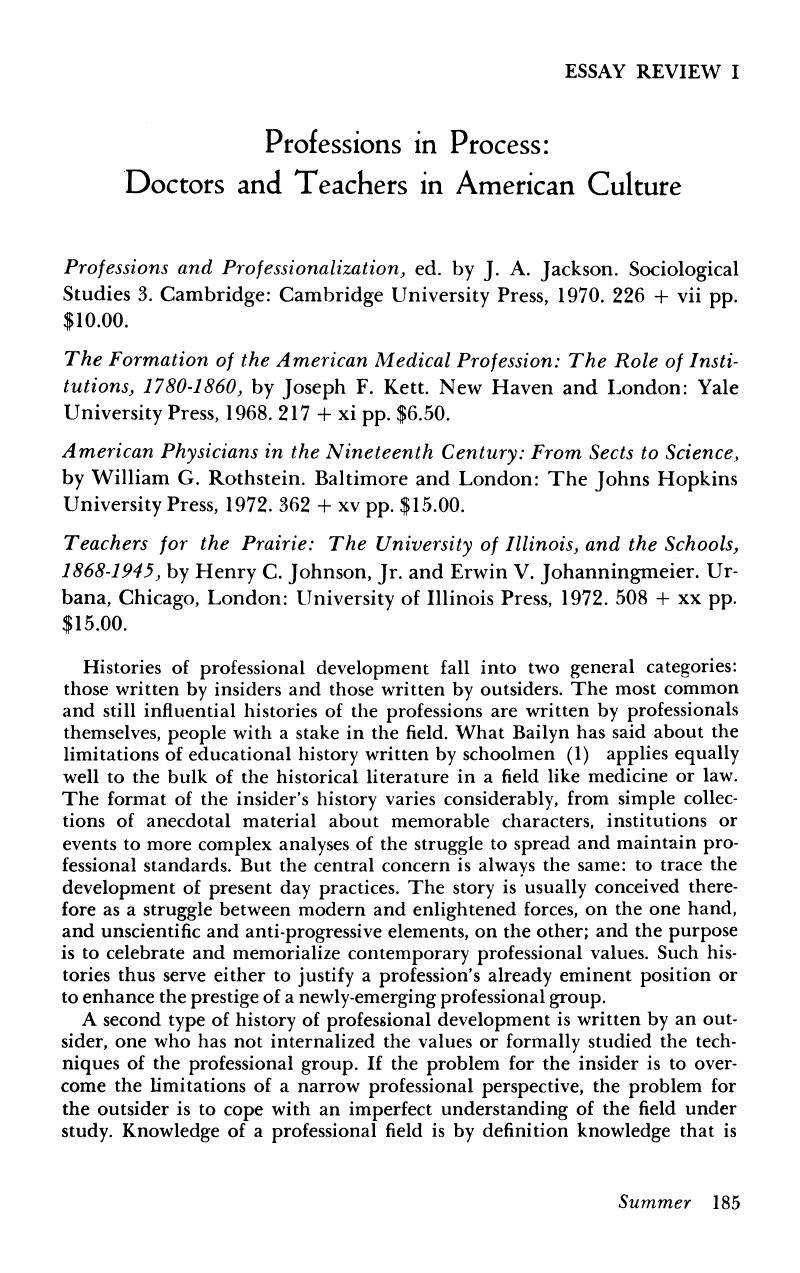Article contents
Professions in Process: Doctors and Teachers in American Culture
Published online by Cambridge University Press: 24 February 2017
Abstract

- Type
- Essay Review I
- Information
- Copyright
- Copyright © 1975 by New York University
References
Notes
1. Bailyn, Bernard, Education in the Forming of American Society (Chapel Hill, N.C., 1960), especially pp. 5–14.Google Scholar
2. Jackson, , p. 3.Google Scholar
3. Ibid., p. 13.Google Scholar
4. Ibid., p. 25.Google Scholar
5. Ibid., p. 24.Google Scholar
6. Ibid., p. 3.Google Scholar
7. Ibid., p. 182.Google Scholar
8. Kett, , p. 13.Google Scholar
9. Kett claims that these states “were not chosen at random but are, in a strict sense, typical.” (p. 13) To support that assertion, he refers the reader to Appendix 1, where he simply summarizes the licensing legislation in the five states studied. There is no reason to believe, then, that these five states are typical, even in a loose sense.Google Scholar
10. Rothstein, , p. 150.Google Scholar
11. Ibid., p. 7.Google Scholar
12. Kett, , p. 95.Google Scholar
13. Fleming, Donald, William H. Welch and the Rise of Modern Medicine (Boston, 1954), p. 4.Google Scholar
14. Kett, , p. 69.Google Scholar
15. Ibid., p. 180.Google Scholar
16. For an excellent analysis of these kinds of questions, see: Mattingly, Paul H., The Classless Profession: American Schoolmen in the Nineteenth Century (New York, 1975).Google Scholar
17. Johnson, and Johanningmeier, , p. 122.Google Scholar
18. Ibid., p. 61.Google Scholar
19. Ibid., p. 39.Google Scholar
20. Ibid., p. 40.Google Scholar
21. Ibid., p. 52.Google Scholar
22. Ibid., p. 101.Google Scholar
23. Ibid., p. 51.Google Scholar
24. Ibid., p. 461–462.Google Scholar
25. Ibid., p. 230–231.Google Scholar
26. Ibid., pp. xi–xii. For another example, see p. 42.Google Scholar
27. Consider, for example, Rothstein, , p. 323, footnote 62, where he asserts that sectarianism (the subject of his study) must be defined as “acceptance of the valid in medicine and rejection of the invalid as practiced by some other group of physicians.” But his study too easily rejects any consideration of “quacks,” who he defines as practitioners who “rejected medically valid therapies outright or else dispensed fraudulent drugs or medical services.” Rothstein, , p. 24. This latter definition determines the parameters of his study thus obscuring, in the nineteenth century, the role of itinerant nostrum peddlars, for example, or, if his study were extended into the twentieth century, I suspect, probably ignoring the challenge of acupuncture to western medical theories. While these definitions that Rothstein offers have their uses (and Rothstein, it must be noted, is not easily trapped by definitions when interesting evidence appears), it might make more sense to simply consider the ways in which a culture dealt with illness.Google Scholar
28. Historians working in other areas have begun to challenge this tendency to reify the categories of historical analysis. For an effort to view the concept of “class” as a set of relationships that change over time see: Thompson, E. P., The Making of the English Working Class (New York, 1964). More recently, Gerald Mullin has analyzed the changing nature of the “slave” experience in Flight and Rebellion: Slave Resistance in Eighteenth Century Virginia (New York, 1972).Google Scholar
29. Crichton, Michael, Five Patients: The Hospital Explained (New York, 1970), p. 43.Google Scholar
30. This point is more fully documented in my article, “Education and Professional Life Styles: Law and Medicine in the Nineteenth Century,” History of Education Quarterly, 14 (Summer 1974): 185–207.CrossRefGoogle Scholar
31. Rothstein, , p. 151.Google Scholar
32. Ibid., p. 281.Google Scholar
- 2
- Cited by




